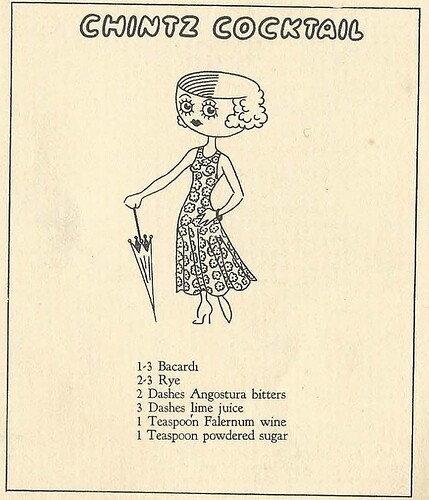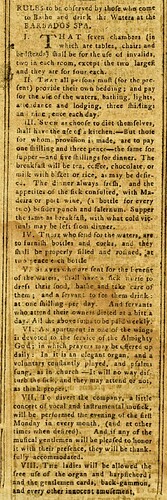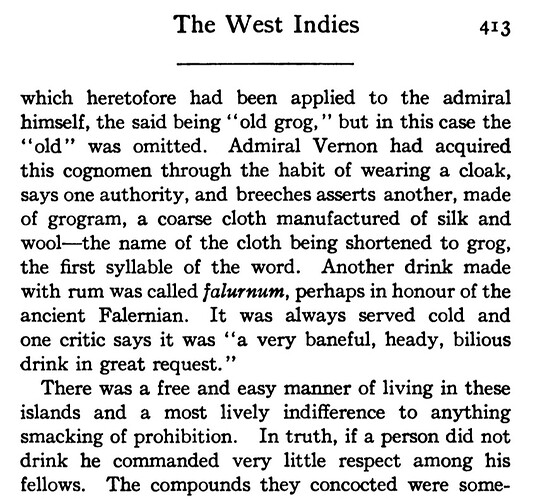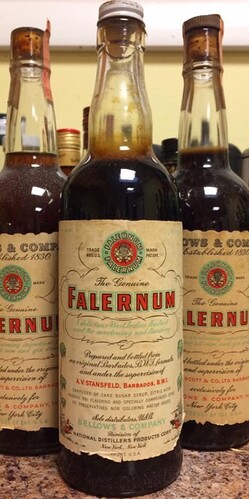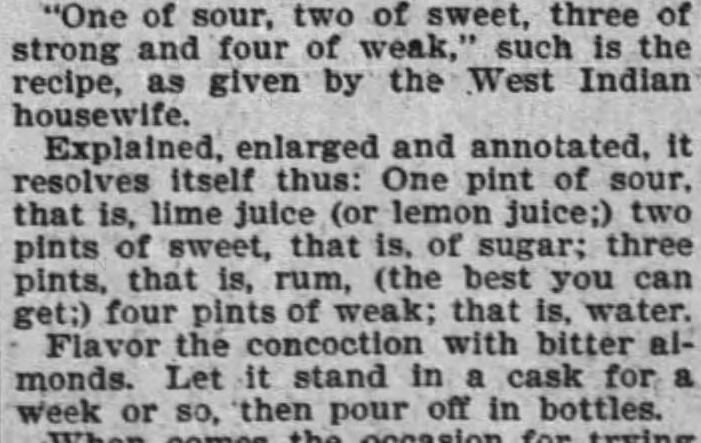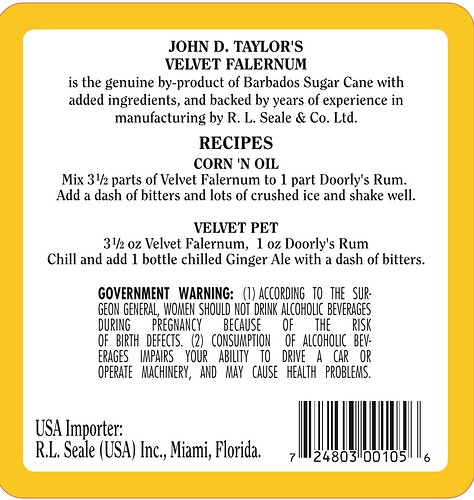Anyone have a handle when and where this drink actually came from? Seems to be Barbadian, but I’m having trouble finding references? Is it a drink actually intended to feature Barbadian black rum? When was anyone on Barbados last selling a black rum?
Simon Difford says, "The Corn ‘n’ Oil is a traditional Barbadian planters’ drink which, like the falernum liqueur it is sweetened and flavoured with, dates from the 1700s. Its ‘Corn and Oil’ name is derived from the Book of Deuteronomy , the fifth book of the Christian Old Testament. Chapters 1–30 are of sermons delivered to the Israelites by Moses on the plains of Moab, shortly before they enter the Promised Land. The salient verse being, "That I will give you the rain of your land in his due season, the first rain and the latter rain, that thou mayest gather in thy corn, and thy wine, and thine oil. "
A recipe for falernum in Mrs. H Graham Yearwood’s 1911 book [we don’t have a copy to verify] is followed by with a notation on its use, "Rum and falernum constitute the drink known as Corn 'n Oil or ‘Corning Oil’ ".
This cocktail’s notoriety was helped by its appearing on the back label of John D. Taylor’s Velvet Falernum, the best-selling brand of falernum."
He also calls for R.L. Seale’s 10 year or Doorly’s XO Barbados Rum.
Yes, thank you. I have seen that. The Deuteronomy business sounds potentially apocryphal, and in classic Difford fashion, no citation is offered. Even if the story behind the name is accurate, where does the “1700s” conclusion come from? Falernum may date to the 1700s—this is documented where?—but the drink doesn’t necessarily.
The Yearwood cookbook quote is certainly interesting, but unless there’s more to it, all that gives us is 1911.
John D. Taylor is a late 19th Century brand, but it’s not clear to me when they began putting Corn ‘n’ Oil on their back label. At some point they also began describing themselves as “The Original Falernum”. R.L. Seale’s 10 Year and Doorly’s XO are aged brown rums, not black, and are recent products. They may make for a better-tasting drink, today, but that doesn’t shed much light on origins. (I’ve noticed that almost everyone is discontent to with the minimalist John D. Taylor version, and they want to add lime juice, and/or bitters or otherwise upgrade the drink.)
If the drink is indeed Barbadian, and roughly turn-of-the-century, then that at least gives one a time frame.
Edit: Beachbum Berry seems to have concluded that falernum is of 19th Century origin (Potions of the Caribbean); Cate’s falernum entry in the OCS talks about falernum being sold alongside Barbadian rums in the early 20th Century… all this seems to point toward a turn-of-the-century era phenomenon, with “Corn ‘n’ Oil” being a creation for the combination of the two products. I guess?
It’s such a mysterious drink and adding to the confusion is that an old style of greek wine was called Falernum ( See Alexis Soyer’s Pantropheon ).
The reference to “Falernum wine” is also mentioned in the Chintz Cocktail as outlined in Bottoms Up from 1934:
I fell into a rabbit hole trying to find the Taylors Falernum label spec origins but sadly never got to a conclusion…
The first drink I could find referencing rum, lime and falernum as a sour was in Frank A. Thomas’ 1936 “Wines, Cocktails and Other Drinks” on page 182.
He says it was “A favorite drink in the British West Indies and Bermuda.” and also earlier defines Falernum as “a sweet by-product of the distillation of rum, used in flavoring.”
The ingredient combo was doing the rounds in the 30s and 40s (with the help of the Royal Bermuda Yacht Club being extremely similar) with Crosby Gaige bonging it under a Daiquiri variation in ratios 4-2-1 of “Daiquiri Coctelera Rum”, lime and Falernum.
As for the actual “clean” rum, bitters and falernum, this doesn’t appear in print for absolute ages… Many variations of sours, swizzles or planters punches appear where rum, bitters and falernum are used but always with the addition of citrus.
The first actual book reference mentioning Corn n Oil (at least to my knowledge…) is the Bitters book from 2011 here:
Given the much deeper Green Swizzle history and how Angostura pushed it with Carypton (See Dr. Siegert’s Angostura book), it seems a reasonable guess that Taylors took the same drink and simply renamed it to Corn & Oil to boost sales with the existing history. (In similar fashion to Bacardi’s attempt at hijacking the Daiquiri with the Bacardi Cocktail, I guess)
[EDIT]
Given the name “Corn & Oil” doesn’t actually appear in print in relation to the drink until relatively recent times, I suspect the label recipe could be a move made by Richard Seale when they bought Taylors in the 1990s?
All speculation though…
My notes from a Richard Seale talk from October 2019 excerpted from here: cocktail virgin slut: corn'n'oil
Back in October, the Boston chapter of the United States Bartender Guild hosted rum distiller Richard Seale at Shore Leave for “A Conversation About Rum.” During the talk, Seale discussed the history of falernum, and he was able to trace it back to a bill of goods of import from 1821 which suggested that it had been around since the 1700s of before on Barbados. Seale declared that falernum was very misunderstood: it was made on a sugar (rum) estate as the every day drink of the planter and not in homes as a folk cordial. All of the distillers had their own recipes including Doorly, Seale, and Taylor, and it was a simple combination of sugar, rum, and lime juice and not a mix of a dozen plus ingredient. Moreover, the alcoholic strength has always been low but high enough to preserve the combination. Spicing probably came into being later as a way to differentiate brands perhaps once the production shifted from plantation production to commercial bottling. While falernum was picked up in the 1930s by Tiki legends like Trader Vic and Donn Beach in drinks ranging from the Royal Bermuda Yacht Club to the Zombie, one of the earliest uses was the Corn’n’Oil. The name derives from Deuteronomy 11:13-15.
While most people will associate that recipe with rum (and the newer versions with black strap rum which would not be traditional found on Barbados), falernum, Angostura Bitters, and sometimes lime juice, Seale mentioned that earlier recipes were different. Seale’s dad’s Corn’n’Oil was half brandy, half falernum, and a dash of Angostura served over crushed ice, and brandy only got replaced by rum after World War I. As evidence, Seale put up the recipe found in the 1911 West Indian & Other Recipes compiled by Mrs. H. Graham Yearwood which mirrored Seale’s father’s preference. When I posted this recipe on Instagram , people questioned how this could be. I brought up the concept of how the Mint Julep was a Cognac drink before it became an American whiskey drink. I explained, “French brandy was what you drank when you were well off, and it gets recorded because those people write the history books as well. Early rum and American whiskey were looked upon as bulk commodity spirits for the common people and not for the cocktail class.”
All this seems plausible to me, including the light rum+gum+lime mixture as, effectively, a “lemonade”-type refresher made from what was already on hand, with the spirits serving as preservative/antiseptic (and undoubtedly supplying a pleasant buzz). The brandy business also seems perfectly plausible. If so, then Taylor is the first—or one of the first—commercial bottlers of some interpretation of this thing. All these “falernums” were diluted before drinking? And perhaps planters on other islands were all doing something similar, because it is obvious (e.g., over on Trinidad)?
I have not been able to locate your Instagram post.
If the Deuteronomy thing holds water, then there’s maybe a story why the passage specifically resonated in Barbados. The full passage (old King James) is:
13 And it shall come to pass, if ye shall hearken diligently unto my commandments which I command you this day, to love the Lord your God, and to serve him with all your heart and with all your soul,
14 That I will give you the rain of your land in his due season, the first rain and the latter rain, that thou mayest gather in thy corn, and thy wine, and thine oil.
15 And I will send grass in thy fields for thy cattle, that thou mayest eat and be full.
So, be a good Christian and your agriculture shall prosper. (“Corn” is “grain” and “oil” is “olive oil”.)
So, now I’m looking for the actual relevant text from the Yearwood book (I haven’t found a PDF, so I guess it’s going to be a trip to the library) and an 1821 bill of goods of import (from where to where?) I wonder what else there might be, particularly from/about 19th Century Barbados?
The earliest mention of Falernum as a Caribbean drink (and not the ancient Roman wine after which it was named) I could find is the same one Matt Pietrek found, from the Barbados Mercury in 1787, which (facetiously) has invalids being given Madeira, Punch and Falernum.
An 1823 ad in the same paper boasts of Falernum made from “clayed sugar” (sugar which is topped with wet clay as it sets so that it will suck the moisture out and wash out much of the molasses) and “rectified spirit.” If this follows the traditional recipe, which calls for rum, sugar, lime juice and water, it would be quite light indeed, even after the two or three years of barrel aging Falernum sometimes got.
As for Corn and Oil–I’ll meet you at the library; there doesn’t seem to be another early source and Yearwood is quoted differently by different authors.
Argh. I had a hunch Pietrek had posted something about falernum but then I wasn’t finding it. Now I’ve found it.
Here’s that Barbados Mercury, August 7, 1787 article, reproduced in full for everyone’s amusement:
I get the impression that falernum went through a couple essential changes in the 19th Century. The early sources consistently describe falernum (or falurnum) as—itself—a drink.
By the end of the 19th Century, it seems falernum has become a concentrate (e.g., Taylor’s, Stansfeld). I presume the concentrate would make it easier to package and ship, and far more shelf stable. It’s not clear to me whether anyone was still adding this syrup to water as a beverage, but perhaps this is exactly where things like Corn ‘n’ Oil come in? The Stansfeld label at some point bills it as “Famous sweetening ingredient for flavoring all rum and gin drinks”. Nevertheless, falernum is still described as a drink in the 1908 Beverages Past & Present, but this may be lore:
Also in the 1907 Pocket Guide to the Caribbean (p.10):
Among other beverages peculiar to the West Indies are pimento
dram and falernum, and the old-time sangaree also has its devotees. It is a good rule to avoid
all stimulants before the midday meal, though an
appetiser before dinner, which may take the form
of a cocktail or a “swizzle,” is recommended.
This one bins pimento dram in there, too, which as far as I know (not all that far) wasn’t typically diluted.
The other big falernum change seems to have been—with the notable exception of the Taylor product—losing the alcohol entirely. Jeff Berry has determined and long maintained that the falernum used in the USA by Don the Beachcomber et al were non-alcoholic spiced syrups, with the Stansfeld product dominating:
Composed of cane sugar syrup, citric acid (alcohol 5%) flavoring and specially compounded spice. No preservatives nor coloring matter added.
(That 5% alcohol ostensibly refers to the “citric acid flavoring” not the bottle as a whole. If so, there must be some real or imagined arcane regulatory explanation for it being mentioned at all.)
Losing the alcohol in the falernum certainly changes the business parameters for its sale.
Thanks to Jeff Berry for the above resources.
Having looked through a metric buttload of Falernum ads from the 19th century I’ve come up with a few tentative conclusions, which mostly play off what Matt wrote.
Falernum began as bottled punch. It did not need dilution, it was ready to drink. It got its name because it was the wine of Barbados, and its makers–almost always distillers on sugar estates–found it delicious. It seems to have been drunk straight, and had no role as a mixer. It was a bottled cocktail, not a liqueur.
Its general formula called for rum, lime juice, sugar and water. I’m sure some of its various makers added a little spice of their on, but I’m equally sure others didn’t. The only ingredients mentioned early on are those four.
As for proportions. If you analyze the two early recipes we have, Mrs. Yearwood’s from 1911 and the one offered by Agnes Lickfold in her Handbook of Trinidad Cookery from 1907, it is clear that they follow the standard Caribbean punch formula, “one of sour, two of sweet, three of strong [and four of weak].” I put the last in brackets because Yearwood left out the weak, but more on that in a moment.
Here’s Lickfold’s recipe:
That works out as:
40 oz lime juice (Imperial measures here)
80 oz sugar
120 oz rum
160 oz water
In other words, one, two, three and four (Yearwood’s recipe works out almost as neatly, at least for the one, two and three).
The cask seems to play an important role here. The aging would allow the lime juice to completely oxidize and develop some bitterness, making for a more interesting beverage (I don’t think there’s enough lime for that to be more that an accent). Some ads mention Falernum two or three years old. Definitely drinking strength.
Going into the cask, anyway, if this was made with a 50% abv rum it would be around 16% alcohol; if one at 57% (British proof) around 19%, and at 69% (20 degrees overproof British) around 23%.
As the 19th century wears on, you see some distinctions arise. In the 1850s, you start to see “white Falernum” and “browwn Falernum” advertised. I think the white must be connected to that early rectified spirit-clayed sugar version, which would be very much on the delicate side, while the brown seems likely to have involved aged rum. (you also see these as “pale” and “golden”).
Up until the end of the century, nobody mentions spice as an ingredient or component to Falernum’s flavor; in 1896, though, the Los Angeles Times printed a little article on the stuff, with the following recipe:
This is the earliest mention of spice I’ve come up with, although to be transparent I should add that I haven’t made a truly thorough search.
By this point, Falernum starts turning up in the Caribbean as a drink ingredient, a vital part of Barbados’s justly famous Green Swizzle. Additionally, Barbados-bottled Falernum is being shipped to Britain and the US. This is often referred to as a “liqueur.” Also considering Yearwood’s waterless forrmula, I wonder if some of the water was omitted to save on shipping.
It’s possible the no-alcohol versions are due to Prohibition. In any case, after Prohibition it was sold in the US as an essential for flavoring an sweetening rum drinks. For this role, it had more spice (Yearwood’s recipe adds brandy, bitter almond and mace; others mention cinnamon and nutmeg).
Besides Yearwood, whose recipe is quoted by Difford’s and by Wikipedia, both differently and both ambiguous about where the quotation leaves off and the editorial bit, begins (said bit possibly including the Corn and Oil part), the earliest mention of Corn and Oil I’ve found is in Emile Freeland’s Tales of a Sugar Tramp, published in New Orleans in 1954:
[Edited because I forgot something.]
Awesome! That all really fills in a ton.
Corn and oil doesn’t seem to make much sense until a liqueur falernum is commonplace, unless it started out just as a way to beef up “white falernum” or “brown falernum”?
Yearwood’s book is in the NYPL catalog but listed as “unavailable”—I’ve sent a query to the librarians.
I’m now curious about the Barbados Green Swizzle. I guess I need to see who still has some “Czech-style” absinthe lying about?
The Green Swizzle was one of the revelations for me when I updated Imbibe back in 2015. What a fantastic drink. And yeah, I also sent a query to the NYPL about Yearwood. Let’s see what happens!
The only mixed drink I could find for the first-state Falernum was an 1835 (Barbados) suggestion to add a little to “citrated Kali” (potassium citrate, in water) to “convert it almost into sparkling champagne.” Pouring more rum into it would be like pouring more vodka into a canned Moscow Mule. You could do it, but it would seem a little desperate.
I’d like more information on the Falernum being imported in the 1890s and early 1900s. The search continues.
Having consulted the 1990 A to Z of Barbadian Heritage excerpted in the notes to Wikipedia’s Falernum entry (Falernum - Wikipedia) I can say that the Difford’s Guide statement that “A recipe for falernum in Mrs. H Graham Yearwood’s 1911 book [we don’t have a copy to verify] is followed by with a notation on its use, ‘Rum and falernum constitute the drink known as Corn ‘n Oil or “Corning Oil”’’” is mistaken; the notation on its use is in fact by the editors of the A to Z. This makes the earliest appearance of the drink I’ve found John Dos Passos’ 1932 novel, Nineteen Nineteen. He has a couple of characters drinking it in a local dive in Dominica. This being a novel, and not reportage, and one by John Dos Passos at that, I wouldn’t conclude from it that the drink was non-Bajian. Who knows where he got it? For what it’s worth, he has someone shaking up Barbados Green Swizzles in his 1943 novel, Number One.
<Capt. Picard face-palm meme photo goes here>
So, the window for Corn ‘n Oil is looking like 1890s–1920s?
As I understand it, Barbados rum came from blenders in that era. According to Richard Seale, blenders like A. V. Stansfeld, Alleyne Arthur, R. L. Seale, and Doorly all bottled and sold both their own rums and their own falernum concentrates in that period. Corn ‘n Oil is the one thing you get when you simply mix those two products.
Seale’s commentary (above) that his father’s Corn ’n’ Oil being a brandy and falernum drink seems to me to significantly shift the perspective on the drink to being a promiscuous and rudimentary cocktail application for falernum, as opposed to a Barbados rum cocktail. Anything goes?
Additional observation:
Contemporary mixologists want to make Corn ’n Oil in a Daiquiri-esque manner, with the largest proportion being rum, and usually with lime juice added. Smuggler’s Cove’s version doesn’t include lime juice, but still makes it a rum drink, sweetened and flavored with falernum.
The Corn ’n Oil recipe on the back label of John D. Taylor is mostly falernum. A bottled cocktail, augmented.
(Thanks Jeff Berry for the label image.)
Thanks for the mention. I have removed the erroneous reference to Mrs. H Graham Yearwood’s 1911 book (which I warned, “we don’t have a copy to verify”) from our Corn ‘n’ Oil page.
One need only say “Sir, find m’food” and someone will oblige.
